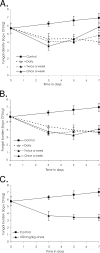Once-weekly micafungin therapy is as effective as daily therapy for disseminated candidiasis in mice with persistent neutropenia
- PMID: 17194830
- PMCID: PMC1803141
- DOI: 10.1128/AAC.01337-06
Once-weekly micafungin therapy is as effective as daily therapy for disseminated candidiasis in mice with persistent neutropenia
Abstract
The effect of micafungin dose scheduling on the treatment of candidemia is unknown. Neutropenic mice with disseminated Candida glabrata infection were treated with single intraperitoneal micafungin doses of 0 to 100 mg/kg of body weight and sacrificed 7 days later. The maximal decline in kidney fungal burden was 5.8 log(10) CFU/g. A 1-week pharmacokinetic-pharmacodynamic study revealed a micafungin serum half-life of 6.13 h. In mice treated with > or =50 mg/kg, there was maximal fungal decline without regrowth during the 1-week dosing interval. Next, doses associated with 34% (34% effective dose [ED(34)]) and 50% (ED(50)) of maximal kill were administered at one of three dose schedules: a single dose at t = 0, two equal doses at t = 0 and t = 3.5 days, and 7 equal doses daily. Some mice received a single dose of 100 mg/kg. Fungal burden was examined on days 1, 5, and 7. In mice treated with the ED(34), microbial kill with the daily therapy initially lagged behind the intermittent doses but exceeded it by day 7. In mice treated with the ED(50), daily and intermittent doses had equivalent day 7 effects. In mice treated with 100 mg/kg, there was no regrowth. The relative likelihoods that the area under the concentration-time curve/MIC ratio was linked to microbial kill versus peak concentration/MIC ratio or time above the MIC was 10.3 and 10,161.2, respectively. In all the experiments, no paradoxical increase in fungal burden was observed with high micafungin doses. However, only a single Candida isolate was tested. Regimens that simulated micafungin concentration-time profiles in patients treated with a single micafungin dose of 1,400 mg once a week demonstrated maximal fungal decline. Once-weekly micafungin therapy is as efficacious as daily therapy in a murine model of disseminated candidiasis.
Figures




Similar articles
-
Anidulafungin pharmacokinetics and microbial response in neutropenic mice with disseminated candidiasis.Antimicrob Agents Chemother. 2006 Nov;50(11):3695-700. doi: 10.1128/AAC.00507-06. Epub 2006 Sep 5. Antimicrob Agents Chemother. 2006. PMID: 16954319 Free PMC article.
-
Treatment of Candida glabrata infection in immunosuppressed mice by using a combination of liposomal amphotericin B with caspofungin or micafungin.Antimicrob Agents Chemother. 2005 Dec;49(12):4895-902. doi: 10.1128/AAC.49.12.4895-4902.2005. Antimicrob Agents Chemother. 2005. PMID: 16304150 Free PMC article.
-
Comparative antifungal activities and plasma pharmacokinetics of micafungin (FK463) against disseminated candidiasis and invasive pulmonary aspergillosis in persistently neutropenic rabbits.Antimicrob Agents Chemother. 2002 Jun;46(6):1857-69. doi: 10.1128/AAC.46.6.1857-1869.2002. Antimicrob Agents Chemother. 2002. PMID: 12019101 Free PMC article.
-
Single or 2-Dose Micafungin Regimen for Treatment of Invasive Candidiasis: Therapia Sterilisans Magna!Clin Infect Dis. 2015 Dec 1;61 Suppl 6:S635-42. doi: 10.1093/cid/civ715. Clin Infect Dis. 2015. PMID: 26567282 Review.
-
Micafungin: a new echinocandin.Clin Infect Dis. 2006 Apr 15;42(8):1171-8. doi: 10.1086/501020. Epub 2006 Mar 14. Clin Infect Dis. 2006. PMID: 16575738 Review.
Cited by
-
Anidulafungin in the treatment of invasive fungal infections.Ther Clin Risk Manag. 2008 Feb;4(1):71-8. doi: 10.2147/tcrm.s882. Ther Clin Risk Manag. 2008. PMID: 18728722 Free PMC article.
-
Efficacy of humanized single large doses of caspofungin on the lethality and fungal tissue burden in a deeply neutropenic murine model against Candida albicans and Candida dubliniensis.Infect Drug Resist. 2019 Jul 1;12:1805-1814. doi: 10.2147/IDR.S198764. eCollection 2019. Infect Drug Resist. 2019. PMID: 31303773 Free PMC article.
-
Echinocandin antifungal drugs in fungal infections: a comparison.Drugs. 2011 Jan 1;71(1):11-41. doi: 10.2165/11585270-000000000-00000. Drugs. 2011. PMID: 21175238 Review.
-
Efficacy of Extended-Interval Dosing of Micafungin Evaluated Using a Pharmacokinetic/Pharmacodynamic Study with Humanized Doses in Mice.Antimicrob Agents Chemother. 2015 Nov 9;60(1):674-7. doi: 10.1128/AAC.02124-15. Print 2016 Jan. Antimicrob Agents Chemother. 2015. PMID: 26552968 Free PMC article.
-
Cardiac Safety of High-dose Micafungin.J Pharmacol Pharmacother. 2017 Jul-Sep;8(3):132-133. doi: 10.4103/jpp.JPP_37_17. J Pharmacol Pharmacother. 2017. PMID: 29081623 Free PMC article. No abstract available.
References
-
- Akaike, H. 1974. A new look at the statistical model identification. IEEE Trans. Automated Control 19:716-723.
-
- Alexander, B. D., W. A. Schell, J. L. Miller, G. D. Long, and J. R. Perfect. 2005. Candida glabrata fungemia in transplant patients receiving voriconazole after fluconazole. Transplantation 80:868-871. - PubMed
-
- Ambrose, P. G., S. J. Bhavnani, C. M. Rubino, A. Louie, T. Gumbo, A. Forrest, and G. L. Drusano. 2007. Pharmacokinetics-pharmacodynamics of antimicrobial therapy: it's not just for mice anymore. Clin. Infect. Dis. 44:79-86. - PubMed
Publication types
MeSH terms
Substances
LinkOut - more resources
Full Text Sources
Medical

